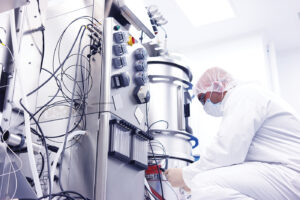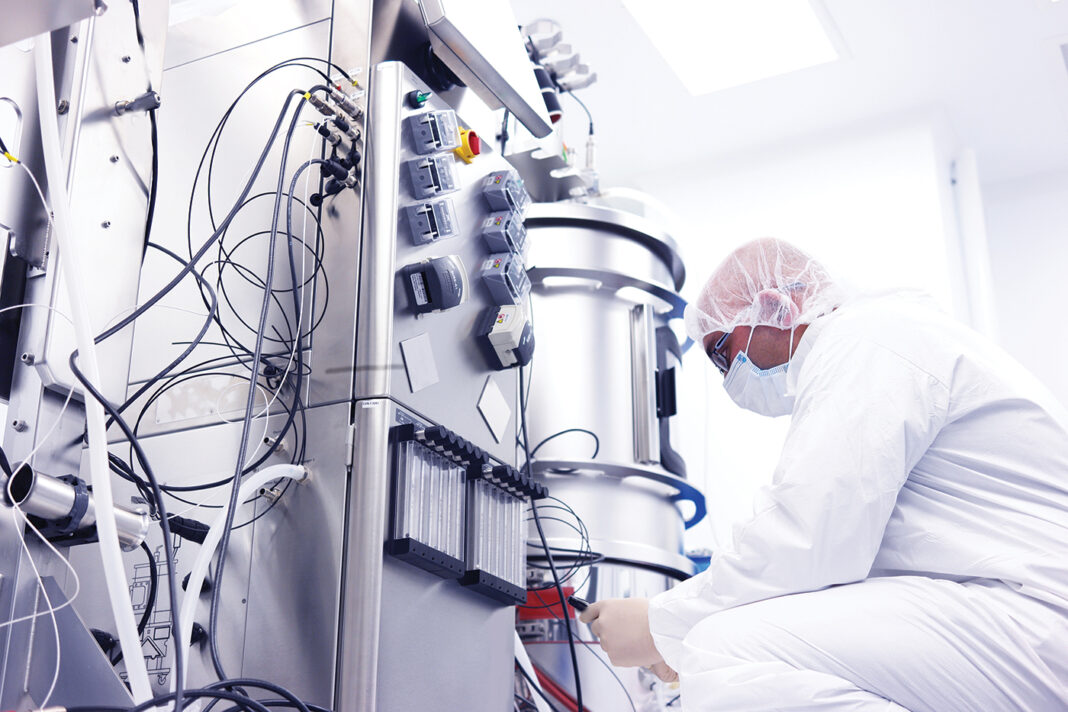A fault line runs through manufacturing. On one side, there is batch processing; on the other, continuous processing. Along the part of the fault line that runs through biomanufacturing, only a few tremors have been felt. That may soon change. According to industry analysts, consultants, and technology experts, the biomanufacturing landscape may soon start shifting beneath our feet.

To be sure, processing in the biomanufacturing industry has been relatively stable compared with processing in other industries—such as the chemical, steel, and consumer goods industries—but in any industry, as in plate tectonics, the longer an inevitable upheaval is delayed, the greater its magnitude may be.
Recently, GEN asked several of its regular contributors—Angelo DePalma, PhD, Gareth John Macdonald, and Mike May, PhD—to assess the forces arrayed along the fault line between batch and continuous bioprocessing. The observations of our biomanufacturing seismologists form the substance of this article. Although our contributors cannot say exactly when the “big one” will occur, all are convinced that it is imminent.
A seemingly immovable object
DePalma cites several factors to explain why the adoption of continuous processing has been so slow. These factors, he says, include 1) inertia, 2) regulatory risks, and 3) the economic disconnect that insulates drug pricing from the “meat and potatoes” economy.
To ensure that the inertia issue is given its due, DePalma quotes Viren Shrivastava, an analyst at Meticulous Research. According to Shrivastava, the biomanufacturing industry’s stasis comes down to a number of practical considerations:
- Huge infrastructure investments are required to integrate continuous unit operations into conventional processes.
- Additional investments are needed to help operators acquire an entirely different skill set.
- As a high-margin industry, the biopharmaceutical industry has been focused on new treatments rather than bioprocess improvements.
- Compared with batch processing, continuous processing requires more elaborate controls and more sophisticated computational resources.
Macdonald attributes the industry’s stasis to the difficulties biomanufacturers experience in collecting data sets that can support sophisticated models. Macdonald reinforces this assertion by highlighting the views of Wolfgang Sommeregger, PhD, product manager at facility design consultancy Bilfinger Industrietechnik.
“In a fully integrated continuous bioprocess, the complexity is extremely high,” Sommereggar notes, “and the use of advanced sensors in combination with process models is almost a prerequisite.”
Process models are only as complete as the data from which they are built. And according to Sommeregger, few biopharmaceutical firms have embraced the continuous bioprocessing approach to the extent needed for accurate models. That is, few firms have embraced Industry 4.0 technologies such as control-enhancing “smart” and autonomous systems.
“One of the benefits of implementing Industry 4.0 technologies is the optimization of the complete value chain,” Sommeregger continues. “However, so far, most applications consider the optimization of only one or a few process steps. [Companies may find] the development of cross-process models [to be] challenging. Many companies struggle already at earlier steps of the implementation.”
Another major hurdle is automating the integration of data. “For enhanced data collection,” Sommeregger says, “the connection of all processing equipment, analyzers, and other devices to a single database/management software becomes necessary.”
Macdonald also consults with John Vitalie, CEO of Aizon, a specialist in industrial artificial intelligence. Vitalie suggests that in the biomanufacturing industry, the diffusion of digital manufacturing technologies will require changes in staff training and corporate culture.
“[It is necessary for companies to] balance regulatory requirements with advances in technology, making change difficult,” Vitalie explains. “Xavier University’s AI in Operations Team, in conjunction with the U.S. Food and Drug Administration, took this challenge on by producing an AI Maturity Model, which outlines some of those cultural challenges.”
Another challenge, Vitalie adds, is knowing where to “begin the journey.” That is, before companies begin, they need to find a project that can make a business value impact.
An unstoppable force
DePalma observes that factors favoring the implementation of continuous processing include rising demand for biopharmaceuticals, the quest for greater efficiencies, biopharma expansion beyond the industrialized world, and advances in continuous processing technology itself. He also suggests that progress in continuous processing may be facilitated FDA initiatives that promote quality by design, risk-based drug development/manufacturing, and process analytics. The FDA, he says, hopes to improve compliance while allowing greater latitude in the deployment of novel manufacturing methodologies.
FDA initiatives are also emphasized by Macdonald, who notes that in 2011, the agency outlined the potential benefits of continued process verification (CPV), suggesting drug companies could use analytical technologies and process data to assess production processes in real time to ensure they achieve product quality specifications.
Macdonald indicates that the drug industry is starting to embrace CPV. To make this point, he highlights the industry’s investments in real-time analytical, modeling, and control technology. He also cites commentary from Vitalie.
“The pharma industry is looking forward to CPV,” Vitalie declares. “This strategy has been defined by the FDA to ensure dynamically the quality of drug manufacturing in real time.
“The major advantage of CPV is that it accelerates batch release. Every single batch can be a ‘golden batch’ if the full manufacturing process is perfectly monitored, and if deviations can be prevented by detecting issues in advance.”
CPV also has the potential to add variability consideration to process development, particularly if artificial intelligence–based control systems are used. “Because all of the relevant factors are identified, and because the inherent variability is included in the control, there are no surprises around unexpected issues in the raw material or equipment,” Vitalie says. “Artificial intelligence plays a fundamental role here, and Aizon, in conjunction with the FDA, in a program called CPV of the Future, is leading one of the main initiatives in this area.”
Something’s got to give
People who discuss continuous bioprocessing often wax paradoxical, as though the technology were simultaneously resistible and irresistible. “On the one hand, the biopharma industry has the reputation of being very conservative; on the other hand, it is also one of the most innovative industries,” Sommeregger relates. “This was impressively demonstrated with the recent generation of several distinct COVID-19 vaccines in a very short time.
“This contradiction is also reflected in the implementation of [continuous processing elements] across the biopharma industry. Many companies are still in the process of improving data management, whereas others are already using artificial intelligence to identify patterns in their data and avert risks.”
Perhaps thin cracks in the old batch processing landscape are starting to widen. “Biomanufacturers are currently applying quality by design and process analytic–based strategies to implement control strategy in continuous processing,” Shrivastava points out. “In addition, the digital revolution will involve the convergence of bioprocessing technologies and such concepts as the Internet of Things, automation and analytics, software, digital twins, artificial intelligence, virtual reality/augmented reality, and machine learning, all of which will be required for the successful implementation of continuous bioprocessing.”

Macdonald indicates that the biomanufacturers are finding that Bioprocessing 4.0—biomanufacturing’s version of Industry 4.0—is facilitating increases in drug quality. Drug quality, he notes, is determined by two things: raw materials and the manufacturing process. For small-molecule medicines, controlling both these factors is straightforward.
However, for biopharmaceuticals, the challenge is much greater. Although using the right material is largely a question of sourcing from the correct supplier, the complexity of biomanufacturing and the reliance on production cell lines make it much harder to control quality.
This is where Bioprocessing 4.0 can help. “In ‘black box’ processes, the quality of the product remains mainly unclear until all subsequent analyses are performed,” Sommeregger says. “However, if advanced sensors are used together with all the other available information, and if the data streams into adequate process models, the product quality can be estimated during the production process.”
A new bioprocessing landscape
In a March 2021 market report, Meticulous Research predicts that demand for products and services related to continuous bioprocessing will grow at a blistering 23% per year, reaching $200 billion by 2027. The study covers filtration and chromatography systems and consumables, bioreactors, sterilizers, centrifuges, incubators, shakers, mixing systems, cell culture media, buffers, and reagents. Key global players include 3M,
Cytiva, Thermo Fisher Scientific, Merck KGaA, Sartorius, Repligen, Eppendorf,
Applikon Biotechnology, Pall, and Bionet.
Broader application of continuous bioprocessing is also driven by improvements in monitoring technologies. These technologies now seem especially attractive because of the pandemic, which has impressed on biomanufacturers the need for technologies that can ensure higher quality products and faster, more efficient manufacturing.
“We are seeing increased interest and investment into digitization of manufacturing facilities,” Vitalie states. “There were already drivers pre-pandemic, but the pandemic brought a need for speed that wasn’t in play before. We think the pandemic will accelerate digitization efforts dramatically. Manufacturers who have this in place are seeing not just efficiencies through the process but increased capacity and flexibility. This is especially important when we consider large production of goods such as COVID-19 therapies and vaccines.”

Artificial intelligence is likely to gain in popularity as pharmaceutical companies seek ways of managing and making best use of increasingly complex process data. “Artificial intelligence is the only path to managing the quickly increasing complexity of data and processes to ensure the best quality of product at a large scale,” Vitalie insists. “Applications will further accelerate the adoption of technology, democratizing access to data and artificial intelligence, not just in one site but across multiple sites or with contract manufacturers.”
Breaking old patterns and building anew
With advances in data analytics and machine learning, the move from descriptive and diagnostic analytics to predictive and prescriptive analytics and controls—allowing us to better forecast and understand what will happen and thus optimize process outcomes—is not only feasible but inevitable, says May. To support this contention, he cites commentary from Bonnie Shum, principal engineer, pharma technical innovation, technology and manufacturing sciences and technology at Genentech.
“Well-trained artificial intelligence systems can help drive better decision making and how data is analyzed from drug discovery to process development and to manufacturing processes,” Shum says. “Those advances, though, only really matter when they improve the lives of patients.”
“The convergence of digital transformation and operational/processing changes will be critical for the facilities of the future and meeting the needs of our patients,” she continues. “Digital solutions may one day provide fully automated bioprocessing, eliminating manual intervention and enabling us to anticipate potential process deviations to prevent process failures, leading to real-time release and thus faster access for patients.”
To turn Bioprocessing 4.0 into a production line for precision healthcare, real-time release and expedited manufacture of personalized medicines will be critical. Adding digitization and advanced analytics wherever possible will drive those improvements. In fact, many of these improvements, especially moving from descriptive to predictive bioprocessing, depend on more digitization.



